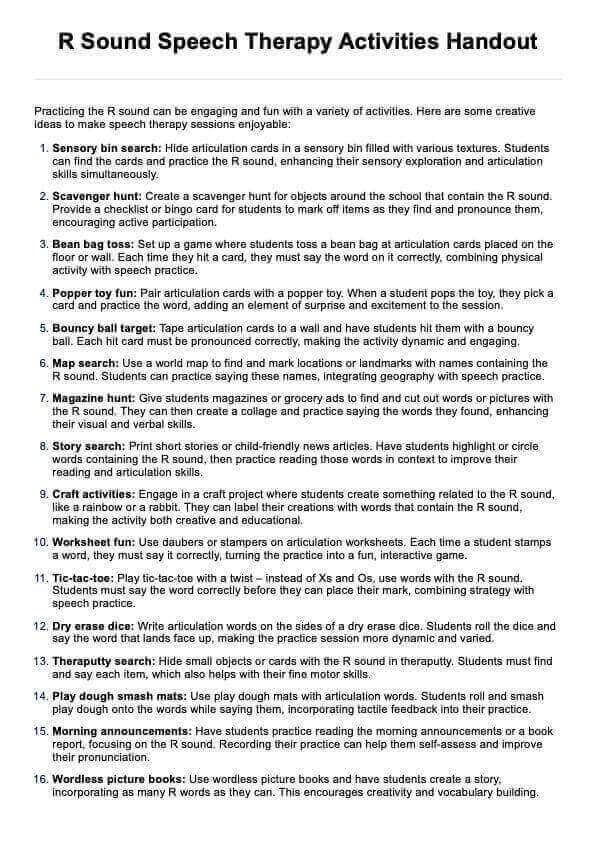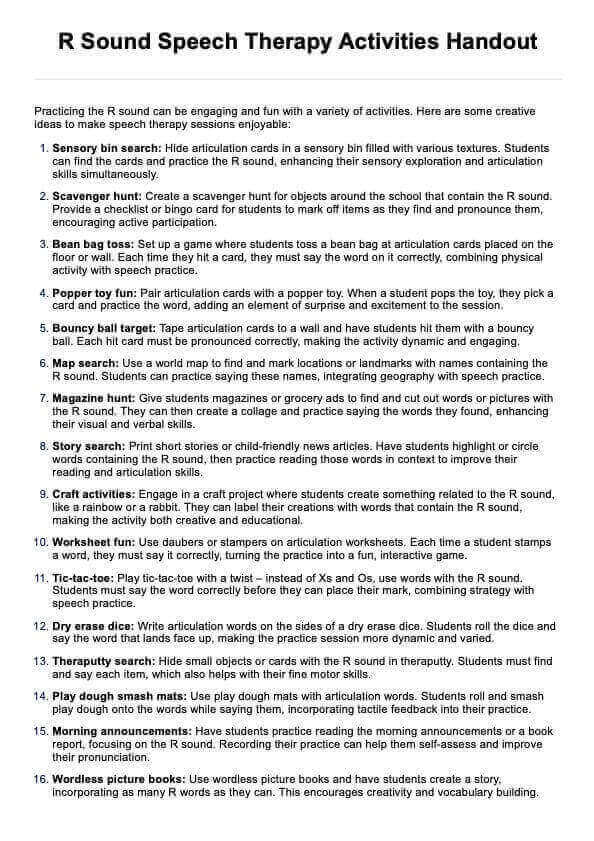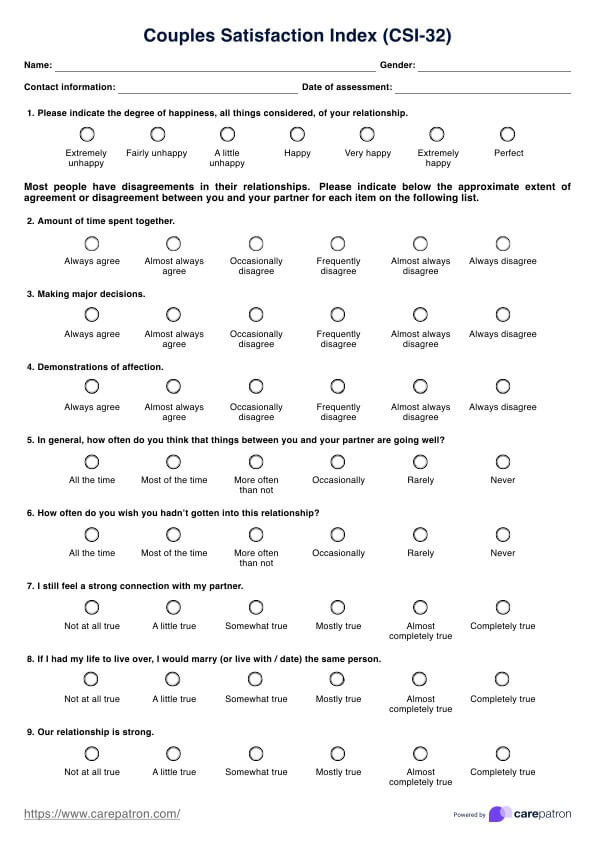R Sound Speech Therapy Activities Handout
Discover engaging activities and strategies to help children master the R sound in speech therapy. Perfect for therapists, teachers, and parents!


What makes the R sound difficult for some people?
The "R" sound can be particularly challenging for many people to pronounce correctly, especially young children and those learning English as a second language. As such, it is an issue that speech-language pathologists often encounter and treat in their patients. Difficulty pronouncing the "R" sound is influenced by several factors:
- Articulation complexity: The "R" sound requires a specific tongue placement and mouth shape, which can vary depending on the context of the word and the surrounding vowel sound. In English, there are multiple ways to produce the "R" sound, each involving complex movements of the tongue and lips.
- Variability: The "R" sound can be pronounced differently depending on region and dialect. For example, the American "R" is often more pronounced and can be vocalized in various positions within words, whereas in some British accents, it might be softened or even dropped.
- Lack of visual cues: The "R" sound is often termed a "non-visible" sound because the tongue's position is not easily seen by others, making it harder to mimic and learn through observation.
- Motor skills: Producing the "R" sound accurately requires refined motor control of the tongue and mouth muscles, which can be challenging for young children whose motor skills are still developing.
- Auditory discrimination: Some people may have difficulty hearing the difference between the "R" sound and other sounds, making it harder to reproduce the sound correctly. These difficulties are common in individuals with speech sound disorders.
R Sound Speech Therapy Activities Handout Template
R Sound Speech Therapy Activities Handout Example
Five R sound speech therapy activities
When working on the "R" sound in speech therapy, various articulation activities can be employed to enhance both the accuracy and fluency of this sound. These activities target different aspects of speech production, including articulation skills, and motor skill development. Below are five speech therapy activities specifically designed for practicing the "R" sound in speech exercises:
1. The vocalic "R"
The vocalic "R" sound can be challenging for children to correct. An effective way of encouraging accurate articulation of the vocalic "R" involves breaking down the "R" sound into its components and practicing each of these separately.
As an activity, children can practice articulating the "er" sound. It is recommended they look in a mirror while doing so, focusing on tongue placement and movement. Gradually, the isolated sound can be incorporated into syllables, own silly sentences, and words, increasing complexity as the patient's proficiency improves.
2. R blends practice
Practicing R blends can help children with the "R" sound. Encourage children to focus on the "R" blends 'br', 'cr', 'dr', 'fr', 'gr', 'pr' and 'tr'. Create a dinosaur-themed worksheet where children can match "R" blend words to corresponding pictures, like "brontosaurus" for /br/ and "dragon" for /dr/.
3. Minimal pair activities for gliding
Minimal pair activities are useful for addressing phonological processes like gliding. These activities involve pairs of words where one contains the target sound and the other contains the error sound, helping children distinguish between them. The speech-language pathologist can read aloud a list of word pairs like "red" and "wed" to practice the R sound. Have the child listen and identify which word is pronounced correctly, then practice saying it themselves.
4. Articulation through play
Incorporating play into articulation practice can make sessions more enjoyable for children. Activities like puppet shows, interactive games, and story creation can be very effective. Use a puppet show to practice /r/ sounds. Have the puppet say target words and encourage the child to repeat them, integrating the words into a fun narrative.
5. Rhyming games
Rhyming games are excellent for practicing the "R" sound while also improving phonemic awareness. For a fun activity, draw a card with a word like "star" and ask the child to find or think of words that rhyme, such as "car" and "jar." Turn it into a challenge to see how many rhymes they can find.
Alternatively, you may use the structure of the game "Memory" with cards that feature different type of "R" sound words, including initial "R" words and vocalic "R" words. These games allow for repetitive practice in a playful, low-pressure environment.
How our R Sound Speech Therapy Activities Handout works
Our R Sound Speech Therapy Activities Handout is designed to provide speech therapists, teachers, and parents with various engaging and effective activities to help children practice and master the "R" sound. The handout is structured to offer a comprehensive range of activities catering to different learning styles and preferences, ensuring that the child's speech and therapy sessions are fun and productive.
Structured to engage and educate
The handout is devised to assist speech language pathologists teach "R" articulation therapy to their clients. The handout offers five targeted strategies to address specific articulation challenges related to the "R" sound. Each strategy includes a sample activity that provides practical examples of implementing the techniques. These strategies focus on breaking down the "R" sound, practicing R" "blends, using minimal pair activities, incorporating play, and using rhyming games to enhance phonemic awareness.
Comprehensive and user-friendly
The handout is structured to convey information in a user-friendly manner. It begins with a list of diverse activities that can be easily integrated into students' everyday routines, making it accessible for both professionals and parents. The detailed descriptions ensure that even those with limited experience in speech therapy can effectively use the activities.
How this handout may benefit speech and language therapists
This handout detailing "R" for speech english language therapy activities can serve as a valuable resource for speech and language therapists in several ways:
- Structured approach: The handout provides a structured framework for addressing the "R" sound, one of speech therapy's most common and challenging articulation issues. This structure can help therapists plan their sessions more efficiently and ensure that they cover all necessary aspects of sound production.
- Diverse strategies: The handout offers a variety of activities, ensuring that therapists have multiple strategies at their disposal. This diversity is crucial because it allows therapists to tailor their approach based on each patient's unique needs, age, and learning style, thereby enhancing individualized care within a varied speech therapy caseload.
- Engagement and motivation: The inclusion of engaging activities like word repetition games and the use of visual cue cards makes sessions more interactive and enjoyable for patients. This can increase motivation and compliance, which are key factors in the effectiveness of speech therapy.
- Professional development: This handout is a professional development tool for new therapists or those looking to refresh their methods. It provides practical techniques and ideas that can be incorporated into their practice, potentially improving their proficiency and confidence in treating articulation disorders.
- Resource for education and training: This handout can be used as a teaching aid in educational settings, such as universities or workshops, where future speech and language therapists are trained. It offers clear examples of practical application of theory, which is essential for bridging the gap between learning and practicing.
Commonly asked questions
The time it takes to master the "R" sound can vary widely among individuals, generally ranging from several months to a few years, depending on factors like age, the presence of other speech issues, and the frequency of articulation therapy sessions. Having your own speech-language pathologist can also help the child master the R sound.
To stimulate the "R" sound in speech therapy, speech therapists often use techniques such as auditory bombardment practice words, visual aids to demonstrate tongue position, and tactile feedback, encouraging patients to feel the vibration or positioning of their tongue.
Children struggle with the "R" sound due to its complex articulation requirements involving precise tongue placement and tension. These vocalic "R" sound articulation requirements can be challenging for children's developing motor skills and auditory discrimination abilities.




















-template.jpg)



















































































